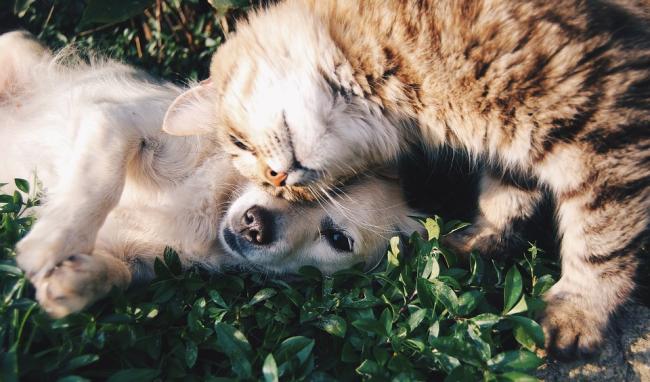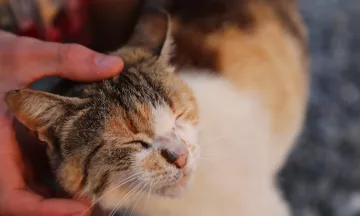Forget what you’ve seen in the cartoons, because the truth about cats and dogs is….they actually can get along swimmingly! And there’s nothing cuter than seeing both species snuggle in a basket together or play gently.

Whether this happens overnight or over weeks and months depends very much on breed, age, background and personality. Be patient, put the needs of both pets first and remember that you as the hooman of the house are IN CHARGE of the situation. So educate yourself, take control, remain positive and don’t be afraid to ask for an expert’s help if you need it.
Consider age and background
A playful puppy and a fearless kitten will have a far better shot at being buddies if they grow up together. An older cat and a younger dog might need a bit longer to get used to each other. A senior dog and a kitten might get along swimmingly. Look at the configuration of age and temperament of the pair you’re bringing together and be realistic about what to expect.
It’s also essential to know the background story of both of your pets, and to put their needs first! If your cat was once traumatised by being chased by an energetic dog, rethink the need to bring a new dog into the home. Or if your dog has been known to attack small animals, likewise reconsider, or enlist the help of a professional trainer. Breed is another issue that you should approach with open eyes – if your dog is a terrier or herding/hunting breed that is known to chase small furry prey, be even more diligent about your cat’s safety
Consider your home
Your home should be spacious enough that you can separate both pets easily so that each has their own safe area. Be sure to keep your cat and dog apart when you aren’t home and make sure your cat has plenty of hidey-holes and high perches to escape to. You may want to consider using baby-gates just to be on the safe side.
Make sure that food, water and litter trays are kept separate and private, as these basic needs can often be the source of conflict or stress between a cat and a dog.
Start slowly with smell
Don’t immediately introduce your pets, and never carry your cat over to your dog and push them together – too much, too fast!
Before physically meeting, make sure both pets are comfortable living separately in your home – rather than getting used to a new space AND a new species at the same time. From here, allow each pet to explore the room the other pet had previously been in and get used to their smell – pat your cat, and let your dog sniff your hand, then the reverse. Then gradually let your pets sniff each other from under a doorway.
Train your dog
Your dog is the real key to success in this new relationship. Make sure they are well trained in basic commands (come, sit, stay, drop) and have your pet sitter or dog walker take them on an epic walk or play in the park before introducing your dog to a cat.
Have some backup toys or treats nearby so that your dog always has a way of venting energy that can be redirected away from your cat.
Nice to meet you!
Keep your dog on a leash and bring them into the room where your cat is. Let each pet look at each other from a distance but keep this first meeting short and sweet. You can extend the length of these meetings gradually as each pet gets used to the other – and always make sure both pets know they are loved and safe by rewarding and praising them separately.
Your cat can wander freely in these interactions, but we recommend keeping the dog leashed until you are confident it won’t chase your cat – from here, a hello through the bars of a baby barrier are a good next step. A cat will usually only attack a dog if they are cornered, so always make sure there is an escape route for your cat.
It might take time, but as these meetings build up you will start to notice both pets getting more comfortable and calm around each other! There is a difference between seeing them sort out the rules with a swat on the snout, to seeing them attack each other – don’t be afraid to ask for help from a trainer or vet. And if you need someone to help supervise while you aren’t home, an experienced Pawshake pet sitter is always just around the corner.






